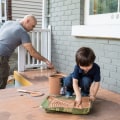Painting a room may seem like one of the easiest DIY tasks in home improvement—but many homeowners quickly learn that even a simple job can turn into a frustrating mess without the right preparation and techniques. From patchy finishes to stubborn roller marks, common painting mistakes can affect the look, feel, and longevity of your project. Thankfully, most issues are avoidable with a little planning and know-how.
Skipping Surface Prep
One of the most overlooked steps in painting is proper surface preparation. Many homeowners jump straight into painting without cleaning the walls or addressing imperfections. Dust, grease, and nail holes will all show through the final coat, ruining that fresh, clean look. Always wash the walls first with a mild detergent and patch any cracks or dents with spackle. Sanding the repaired areas smooth is essential, as is priming to create an even surface for your topcoat.
Choosing the Wrong Paint Type or Finish
Not all paints are created equal, and using the wrong one for the space can backfire. For example, flat paint might look great in a living room but will stain easily in a high-traffic kitchen or hallway. Glossy finishes may highlight wall imperfections, while matte finishes can make small rooms feel cozy but difficult to clean.
It’s also important to choose paint that’s appropriate for the material you’re covering—wood, drywall, metal, and masonry each require specific formulas. If you're unsure, don't rely solely on label descriptions. Research product reviews or speak with a paint specialist to match your goals with the right product.
Ignoring the Tape Line
Painter’s tape can be a lifesaver for clean lines, but only if it’s applied correctly. Too often, homeowners press tape too lightly or fail to seal the edges, causing paint to bleed underneath. The key is to firmly press the tape down with a putty knife and remove it at the right time—typically when the paint is dry to the touch but not fully cured. Waiting too long may cause the paint to peel off with the tape, damaging your clean edge.
Overloading the Brush or Roller
Another common error is overloading the brush or roller with too much paint. This leads to drips, splatters, and uneven coverage. Instead, lightly dip your tool and let excess paint drip off or roll it on the tray. Use long, even strokes and overlap slightly to avoid lines and patches. Applying multiple thin coats is far more effective than one heavy coat, even if it takes a little more time.
Rushing the Job
Impatience often leads to cutting corners, which rarely pays off. Whether it’s failing to let the first coat dry or trying to paint too large an area at once, rushing can result in streaks, uneven color, and paint that peels prematurely. Good painting requires pacing—give yourself time, take breaks, and always allow adequate drying between coats.
Don’t Forget the Cleanup
Finally, many DIYers make the mistake of skipping proper cleanup, leaving brushes stiff, rollers ruined, and leftover paint containers improperly sealed. Taking care of your tools means they’ll last for future projects and ensures a professional result every time.
If you're unsure where to start, how to prep your surfaces, or which materials to buy, don’t hesitate to visit website for expert guides and recommendations to help make your next painting project smooth, stress-free, and successful.






